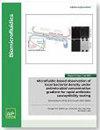Advances in textile-based microfluidics for biomolecule sensing
IF 2.4
4区 工程技术
Q2 BIOCHEMICAL RESEARCH METHODS
引用次数: 0
Abstract
Textile-based microfluidic biosensors represent an innovative fusion of various multidisciplinary fields, including bioelectronics, material sciences, and microfluidics. Their potential in biomedicine is significant as they leverage textiles to achieve high demands of biocompatibility with the human body and conform to the irregular surfaces of the body. In the field of microfluidics, fabric coated with hydrophobic materials serves as channels through which liquids are transferred in precise amounts to the sensing element, which in this case is a biosensor. This paper presents a condensed overview of the current developments in textile-based microfluidics and biosensors in biomedical applications over the past 20 years (2005–2024). A literature search was performed using the Scopus database. The fabrication techniques and materials used are discussed in this paper, as these will be key in various modifications and advancements in textile-based microfluidics. Furthermore, we also address the gaps in the application of textile-based microfluidic analytical devices in biomedicine and discuss the potential solutions. Advances in textile-based microfluidics are enabled by various printing and fabric manufacturing techniques, such as screen printing, embroidery, and weaving. Integration of these devices into everyday clothing holds promise for future vital sign monitoring, such as glucose, albumin, lactate, and ion levels, as well as early detection of hereditary diseases through gene detection. Although most testing currently takes place in a laboratory or controlled environment, this field is rapidly evolving and pushing the boundaries of biomedicine, improving the quality of human life.基于纺织品的微流体技术在生物分子传感方面的进展
基于纺织品的微流控生物传感器是生物电子学、材料科学和微流控等多学科领域的创新融合。它们在生物医学方面的潜力巨大,因为它们利用纺织品实现了对人体生物兼容性的高要求,并符合人体的不规则表面。在微流体技术领域,涂有疏水材料的织物可作为通道,通过这些通道将液体精确地输送到传感元件,在这种情况下,传感元件就是生物传感器。本文简要概述了过去 20 年(2005-2024 年)生物医学应用中基于织物的微流控技术和生物传感器的发展现状。本文使用 Scopus 数据库进行了文献检索。本文对所使用的制造技术和材料进行了讨论,因为这些技术和材料是基于纺织品的微流控技术进行各种修改和改进的关键。此外,我们还探讨了基于纺织品的微流控分析设备在生物医学应用中存在的不足,并讨论了潜在的解决方案。丝网印刷、刺绣和编织等各种印刷和织物制造技术推动了基于纺织品的微流控技术的发展。将这些设备集成到日常衣物中,有望在未来实现生命体征监测,如葡萄糖、白蛋白、乳酸和离子水平,以及通过基因检测早期发现遗传性疾病。虽然目前大多数检测都是在实验室或受控环境中进行的,但这一领域正在迅速发展,并不断突破生物医学的界限,提高人类的生活质量。
本文章由计算机程序翻译,如有差异,请以英文原文为准。
求助全文
约1分钟内获得全文
求助全文
来源期刊

Biomicrofluidics
生物-纳米科技
CiteScore
5.80
自引率
3.10%
发文量
68
审稿时长
1.3 months
期刊介绍:
Biomicrofluidics (BMF) is an online-only journal published by AIP Publishing to rapidly disseminate research in fundamental physicochemical mechanisms associated with microfluidic and nanofluidic phenomena. BMF also publishes research in unique microfluidic and nanofluidic techniques for diagnostic, medical, biological, pharmaceutical, environmental, and chemical applications.
BMF offers quick publication, multimedia capability, and worldwide circulation among academic, national, and industrial laboratories. With a primary focus on high-quality original research articles, BMF also organizes special sections that help explain and define specific challenges unique to the interdisciplinary field of biomicrofluidics.
Microfluidic and nanofluidic actuation (electrokinetics, acoustofluidics, optofluidics, capillary)
Liquid Biopsy (microRNA profiling, circulating tumor cell isolation, exosome isolation, circulating tumor DNA quantification)
Cell sorting, manipulation, and transfection (di/electrophoresis, magnetic beads, optical traps, electroporation)
Molecular Separation and Concentration (isotachophoresis, concentration polarization, di/electrophoresis, magnetic beads, nanoparticles)
Cell culture and analysis(single cell assays, stimuli response, stem cell transfection)
Genomic and proteomic analysis (rapid gene sequencing, DNA/protein/carbohydrate arrays)
Biosensors (immuno-assay, nucleic acid fluorescent assay, colorimetric assay, enzyme amplification, plasmonic and Raman nano-reporter, molecular beacon, FRET, aptamer, nanopore, optical fibers)
Biophysical transport and characterization (DNA, single protein, ion channel and membrane dynamics, cell motility and communication mechanisms, electrophysiology, patch clamping). Etc...
 求助内容:
求助内容: 应助结果提醒方式:
应助结果提醒方式:


